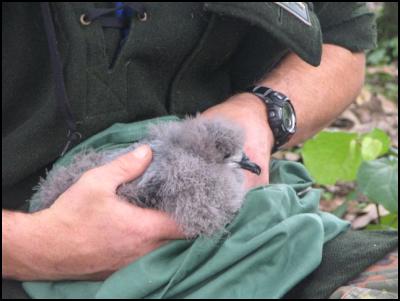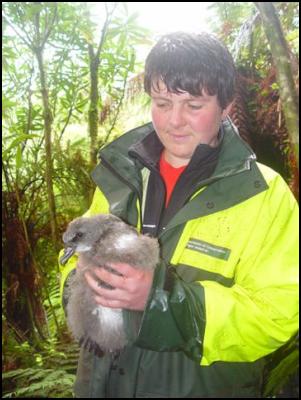Chatham Island seabird successes
9 June 2006
Chatham Island seabird successes
owe much to predator control

Predator control has played a large part in two major seabird conservation achievements on the Chatham Islands.
The successful fledging this week of the first chick produced by Chatham petrel on Pitt Island for more than a century follows the fledging of a record 11 Chatham Island taiko (Magenta petrel) chicks late last month. Once presumed extinct, these taiko are thought to be the world’s most endangered seabird.

DOC technical support officer for the Chatham Islands Dave Houston said the world population of Chatham petrels had been confined to Rangatira Island, a small island off the coast of Pitt Island until efforts to create a second breeding population began in 2002. Over four years 200 Chatham petrel chicks were transferred to a predator-free area on Pitt Island. So far four of these transferred birds have returned and one pair bred, in the fenced 40ha Ellen Elizabeth Preece Conservation Covenant (Caravan Bush).
“It’s the first time this has been achieved with Pterodroma petrels in New Zealand,” Mr Houston said.
“DOC staff, volunteers and Pitt Islanders are rapt with this success.”
The population of Chatham petrels is estimated at around 1000 birds and the establishment of a second breeding site will increase the security of the species.
Mr Houston said the fledging of all 11 taiko chicks produced this season was another landmark for seabird conservation on the Chathams.
“It was the highest number of chicks to fledge since this formerly presumed extinct species was rediscovered by ornithologist David Crockett in 1978.”
There are now an estimated 120 to 150 Chatham Island taiko.

Mr Houston said predator control had been the key to the success with both these sea bird species. - at Pitt Island through the use of a predator-proof fence and at the taiko breeding area on Chatham Island by sustained predator control.
“A lot of people have put in a lot of hard work to achieve these successes.”
DOC seabird scientist Graeme Taylor said that while the fledging of these chicks was a milestone in the recovery of both species, it was a long road ahead. The Chatham petrel chick is likely to return to breed when around three to five years of age, and the taiko chicks will not start to breed until six to nine years of age.
ENDS


 Bill Bennett: Download Weekly - 100% claim lands One New Zealand in criminal court action
Bill Bennett: Download Weekly - 100% claim lands One New Zealand in criminal court action FSCL: Woman Scammed Out Of $25,000 After Job Offer On LinkedIn
FSCL: Woman Scammed Out Of $25,000 After Job Offer On LinkedIn NIWA: Cheers To Crustaceans - New Species Named After Welly Brewery
NIWA: Cheers To Crustaceans - New Species Named After Welly Brewery MBIE: Trans-Tasman Earth Observation Research Studies Confirmed
MBIE: Trans-Tasman Earth Observation Research Studies Confirmed NZ Association of Scientists: Royal Society Te Apārangi Governance Submissions Close - NZAS Submission
NZ Association of Scientists: Royal Society Te Apārangi Governance Submissions Close - NZAS Submission HortPlus: Project Aims To Improve Quality Of Weather Data In New Zealand
HortPlus: Project Aims To Improve Quality Of Weather Data In New Zealand



